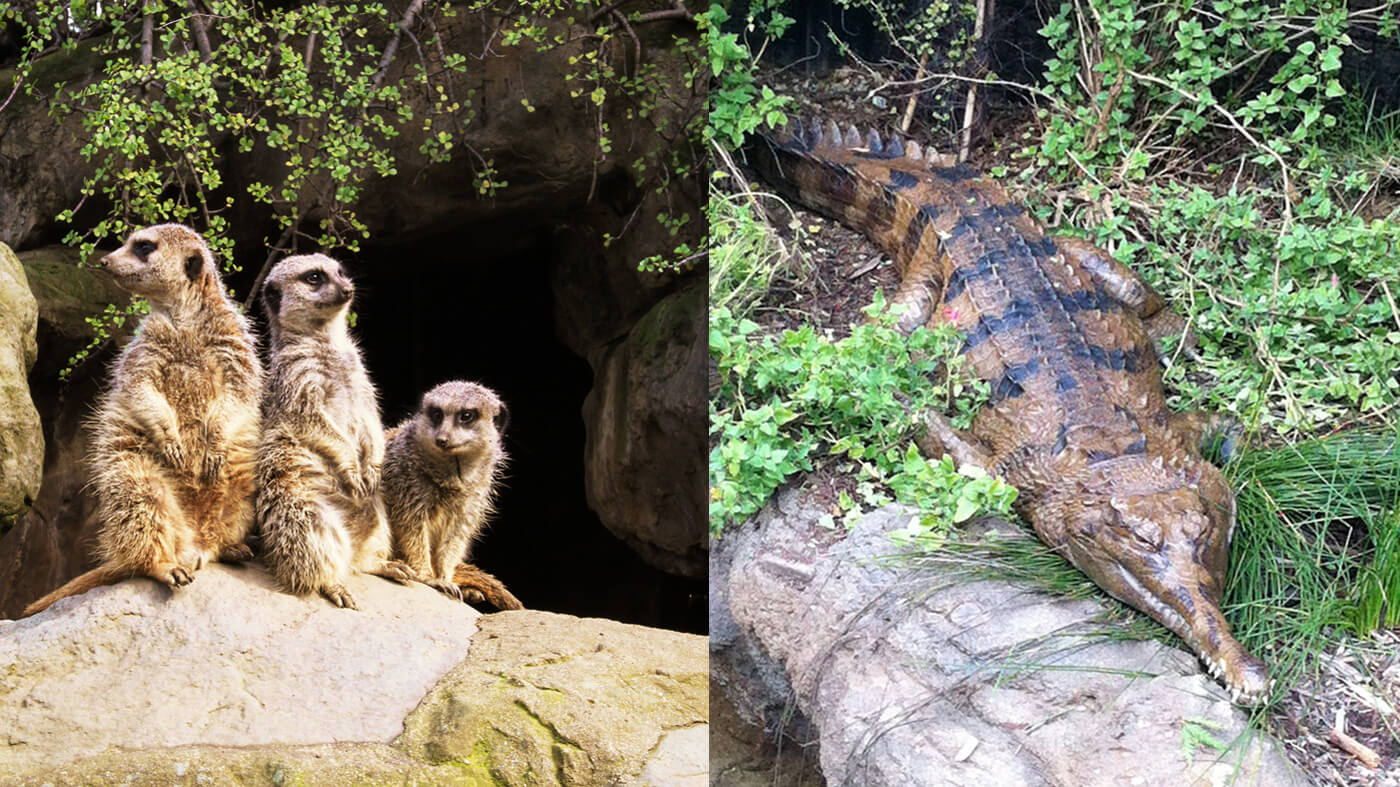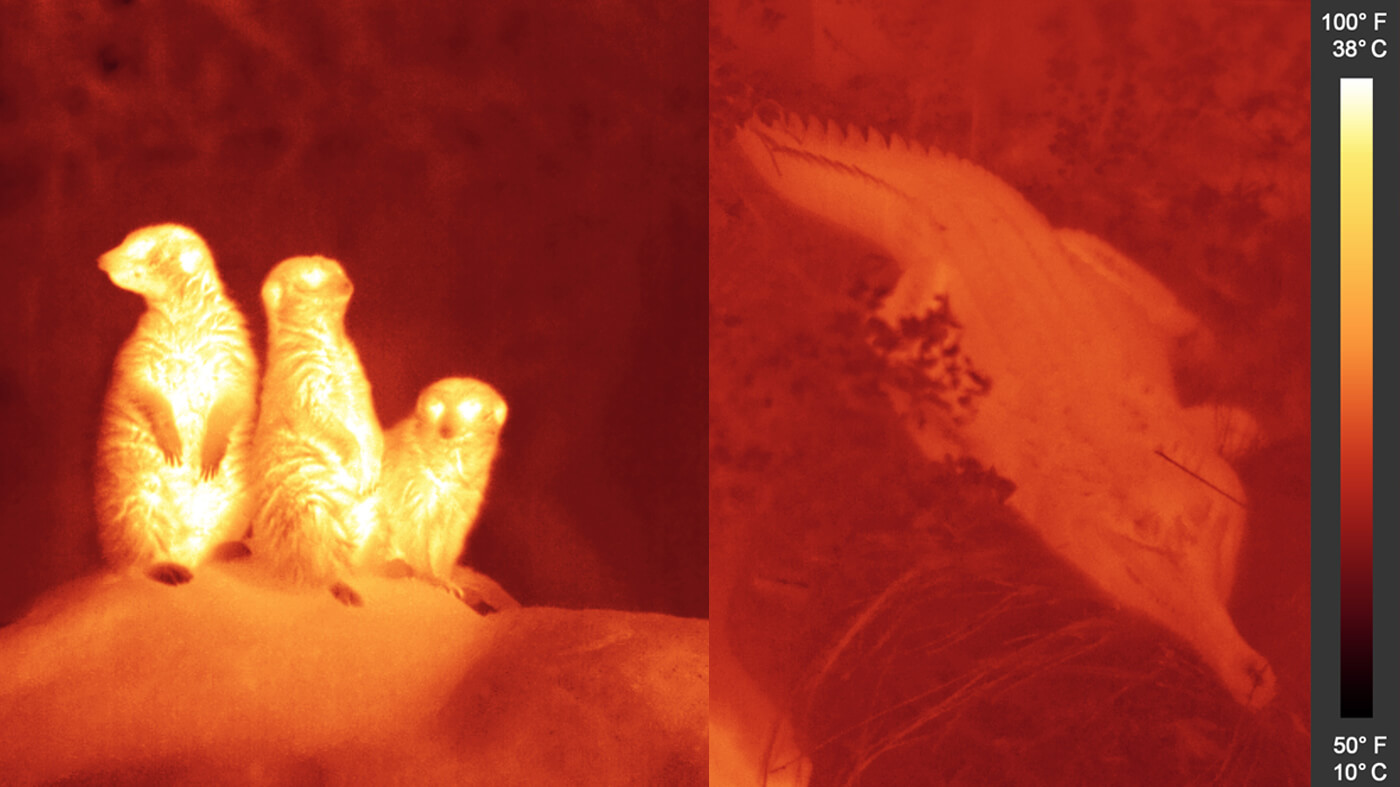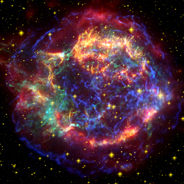Interactive Overview
Slider Interactive: A side-by-side comparison of two animal photographs. The image on the left is a face-on view of three meerkats on a rock, two standing on their hind legs and the third crouching with all paws on the ground. Each meerkat is looking in a different direction. Foliage is hanging down in the background.
The photo on the right shows a tomistoma, a type of freshwater crocodile, lying on a large stone partially covered in vegetation. The oblique perspective provides a view of the back and side of the animal, from mouth to tail.
Below the caption is a horizontal slider bar with two labeled stops and a solid white circle. Dragging the white circle from left to right (and vice versa) causes the two photographs’ color and contrast, as well as the caption and labels to change. The change occurs gradually as one image, along with its associated caption and labels, fades out and the next fades in. A toggle button at the upper right of the image turns the image labels off and on. The labels are in the form of text with arrows pointing to specific features in the photographs.
Slider Stops
From left to right, the slider stops are labeled: Visible and Infrared.
Summary of Slider Stops
Sliding left to right reveals the following:
- “Visible” stop shows the colors of visible light reflecting off the meerkats and tomistoma and their surroundings. This is the initial image shown when the interactive is loaded.
- “Infrared” stop shows the infrared glow from the meerkats and tomistoma and their surroundings.
Stop 1: Visible
Image Description: Visible
These photographs are shown in visible light. On the left, the meerkat trio is sitting on some rocks outside of a small dark cave with green vegetation hanging down from above. The meerkats have fluffy, golden fur that fades to a shade of almost-white on their bellies. The fur blends into the tan color of the rock they are sitting on. On the right, the tomistoma is lying on the ground, with vegetation on either side and its head resting on a rock that juts into a small body of water. The tomistoma has scales with ridges running down its back and along its tail. Its scales are brown with dark brown horizontal stripes across its back.
Labels: Visible
There are four text labels. The mammals on the left are labeled “Meerkats.” Their golden fur, which is similar in color to the rock they are sitting on, is labeled “Camouflage coloration.” The reptile on the right is labeled “Tomistoma.” One of the dark brown horizontal bands that run across the reptile’s back is labeled “Striped pattern.”
Caption: Visible
Visible light provides us with detailed information about our environment, including colors and textures.
Stop 2: Infrared
Image Description: Infrared
Moving the slider bar toward the right reveals infrared images of the same scenes, with many of the animals’ physical characteristics apparent in “Visible” no longer seen. A vertical gradient bar on the right side shows the correlation between color and temperature, from dull, dark orange (cooler) at the bottom of the bar to bright, light yellow (warmer) at the top. The warm-blooded meerkats in the left photo glow brightly in orange and yellow tones indicating that they are relatively warm. The rock they are sitting on and the foliage behind them are dark orange (cooler). On the right side of the image, the cold-blooded tomistoma has a dull and muted orange color significantly darker (cooler) than the meerkats, but brighter (warmer) than most of its surroundings, including the stone and vegetation. The edge of some water is more visible at the lower left-hand corner of the image in the infrared. It appears to be similar in brightness to the tomistoma.
Labels: Infrared
There are two text labels. The meerkat trio is labeled “Warm-blooded.” The tomistoma is labeled “Cold-blooded.”
Caption: Infrared
Infrared light shows less detail, but the warmth from animal bodies glows dramatically.





